Most offices and home studies today are full of electric and electronic equipment: personal computers, monitors, lamps, printers, scanners, network cables ....
Many of these devices emit electromagnetic fields of various kinds, which are very dangerous for people who work or live near them for many hours a day.
In this web site you can find information about our long research of solutions to achieve good office equipment without the threat of these electromagnetic emissions.
Sources of electromagnetic fields and radiation
- Tablet computers
- LCD monitors
- LCD monitors with LED backlight
- Desktop computers
- Laptop computers
- Desktop lamps
- Fluorescent light tubes
- Incandescent light bulbs
- LED light bulbs
- Computer mouse
- Computer keyboards
- Network cables
- ADSL splitters
- ADSL wires
- Tables and desks
- Power cords
- USB cables
- USB hubs
- USB LED lamps
- Wireless devices and networks
- Wireless computers and accessories
- VGA cables
Examples of some solutions
- Low EMF computer display
- Low EMF desktop lamps
- Computer mouse shielding
- Computer keyboard shielding
- Shielded power cords
Other articles
- For electrosensitives
- The problem of computer displays
- Problem of cables in offices
- Office cables study with 3D model
- Problems of switching power supplies
- Modified LCD monitor arrangement
- Modified monitor power supply
- Gallery of modified LCD monitors
- Construction of a shielded keyboard
- Test of a recent LCD monitor with LED backlight
- KVM extensions to reduce electromagnetic exposure
- LCD monitor with modified power supply
- New project of low EMF computer display
- Low EMF LCD monitor
- Results of power cords shielding
- Summary of our results
Product reviews
- Shielded power cord
- Shielded socket outlet
- Comparison of shielded power cords
- Low frequency EMF meter
General information
Electromagnetic emissions of LCD monitors with LED backlight
In the last few years the technology of LCD monitors has finally adopted the LED backlight. There are some advantages and some improvements in these new products. First the LED backlight requires much less power than the fluorescent tubes. Second, the LED light can give a slightly better appearance to the LCD picture because of the different spectrum of colors.About the picture quality
In practice, the difference between the picture quality with LED backlight or with fluorescent backlight is very small. It is a matter of use. After having seen some LCD monitors with LED backlight on the shelves people do not notice them anymore. It is probably an effect related to the change. The human sight is more sensible to changes in colors and brightness, than to the absolute values of colors or brightness, so after some time we are perfectly accustomed to a kind of picture even if it has lower brightness and a narrower color range. What we are concerned about is instead the electromagnetic field and radiation.Electromagnetic emissions
The EMF emissions of LCD - LED monitors are lower respect to LCD monitors with fluorescent tubes, but there is still some very nasty EM radiation.First of all, the power supply is usually internal, and since it is of switching type it creates a lot of electromagnetic emissions on a wide frequency band. Even if the power supply is external, its emissions are carried by the wire and enter in the monitor circuits.
Second, the LCD control board is still attached to the back of the LCD module.
Third, the various voltages needed by the LED backlight and the other components are obtained by means of DC-to-DC converters which are electronic circuits that work in the same way of switching power supplies. These circuits are embedded in the monitor box, just like the power supply and the control board.
Finally the LEDs are used with a pulsed current at medium frequency.
Possible solutions
At first sight, one may think that a commercial LCD monitor with LED backlight could be modified by replacing its internal, or external, power supply with a low EMF one, but in practice this is not possible.To avoid all electromagnetic radiation from the backlight we have to power the LED with smooth DC current, like that from a battery, but to do this the LEDs must be already wired in a suitable circuit for low voltages.
Instead the industries have adopted a more complex circuit with LEDs that works with high voltage, 60 - 100 V, and the current is not constant but pulsed at a medium frequency, 10 kHz - 60 kHz. They do this because in this way the average brightness of the LEDs can be easily trimmed with a small electronic circuit, called a PWM modulator. Instead, the circuits for having a smooth DC are bigger and heavier, and could not be fitted inside a super-slim LCD monitor. Another reason for using the PWM is that there is less lost power, a simple DC circuit usually has to waste some power to achieve the desired voltage, but in practice this would be a very small power, so the true reason because they use the LEDs with a PWM circuit is the smallness of this circuits.
So in practice it is not possible, in general, to simply detach the original power supply and attach another one. Even if we discard the PWM and put the LEDs on a constant voltage, the circuit requires a high voltage, and such high voltage is dangerous, and obtaining a smooth DC voltage of such value requires a power supply even bigger and heavier than usual.
Conclusions
LCD monitors with LED backlight are indeed a little better than LCD monitors with fluorescent backlight for what concerns electromagnetic emissions. If one wants to buy an LCD monitor and he or she is worried about electromagnetic emissions, then the LED backlight ones are surely better.However this products, as usual, are not designed to avoid electromagnetic emissions as more as possible. They are designed for esthetic appearance only, so they still have a noticeable amount of electromagnetic radiation, especially on the middle and high frequencies, that people who is already partially injured by electromagnetic radiation from monitors and other sources would notice immediately.
Cell Phone Protection: How to Protect Yourself From Cell Phone Radiation, Mobile Phone Radiation, Cell Towers, Televisions, Computer Screens, Fluorescent Lights, WIFI Hotspots, & Other Sources of Negative Radiation Which Harm Your Thinking, Flexibility, Strength, Balance, & Immune System...
Protect Yourself with a Mind Body Healing Device
http://frequencyshield.com/
Why are cell phones dangerous? Cell phone radiation disrupts cellular communication (between the cells of your body) and between your mind and your cells which creates stress and stress kills.
According to Dr. Bruce Lipton, cellular biologist and author of "Biology of Belief"; the communication between your cells and your mind is more important to your health than your genes or your DNA, which are blueprints containing all possibilities... Your cells are told what to use and when to use what via frequencies from your autonomic nervous system which can be sabotaged by cell phones and other forms of EMF radiation pollution.
You need EMF Protection (Electromagnetic Frequency Protection) so that the communication which protects your Mind, Body, Spirit can function as designed.
Watch our You Tube Video for a demonstration of some to the ways Cell Phones and similar radiations harm you. Enter your email address to see your Frequency Shield Free Trial Offer. That means you can pay after you test 1 emf shield for yourself by recreating your You Tube video demonstration.
Your "Thumbs Up" for our video and 2 lovely ladies are appreciated.
http://frequencyshield.com/
http://www.youtube.com/watch?v=k1yFwQ...
Gallery of modified LCD monitors with low electromagnetic emissions
In this page you can see a gallery of modified LCD monitors. The monitors have been listed using their original brand name and model name, however this information is completely irrelevant, since the original monitors had been modified deeply. Industries do not care about the electromagnetic emissions, so the more expensive products in commerce generally are not the best in term of EM emissions. Instead, the quality of the picture is more or less the same for all brands. Consider also that monitor's manufacturers buy the LCD panels and other components from the same manufacturers of LCD panels so often you can find the same LCD panel inside different brands of monitors. On the other way, often two monitors of the same brand and model have different internal components.Currently, the best choice for a modified monitor are the 19" 16:10 with VGA input, because they are easier to modify, have small circuit boards, and cost also less as used.
Modified HP 1702, 17" 5:4, 1280 x 1024 , VGA.
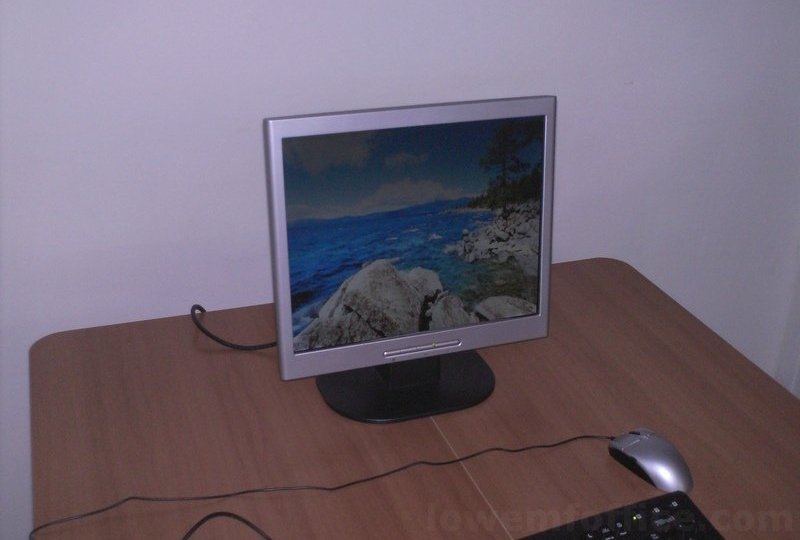 Modified Acer AL1716, 17" 5:4, 1280 x 1024 , VGA.
Modified Acer AL1716, 17" 5:4, 1280 x 1024 , VGA.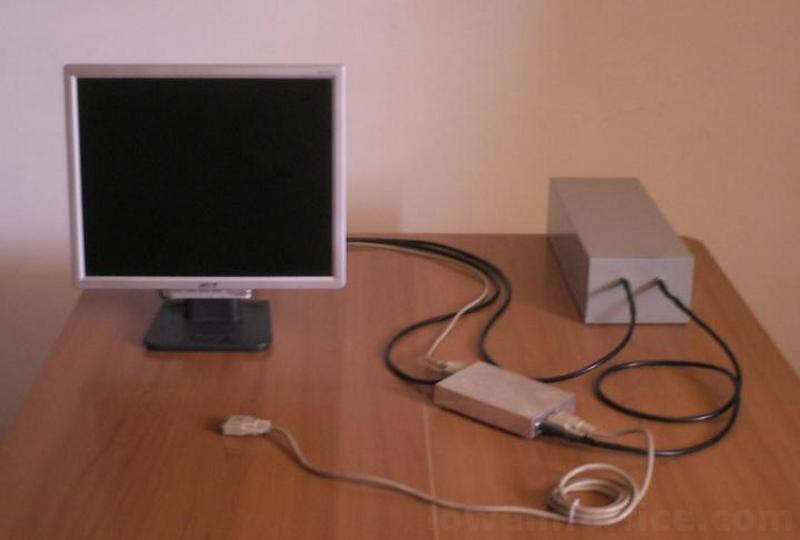 Modified Hyundai X91W, 19" 16:10, 1440 x 900, VGA + DVI
Modified Hyundai X91W, 19" 16:10, 1440 x 900, VGA + DVI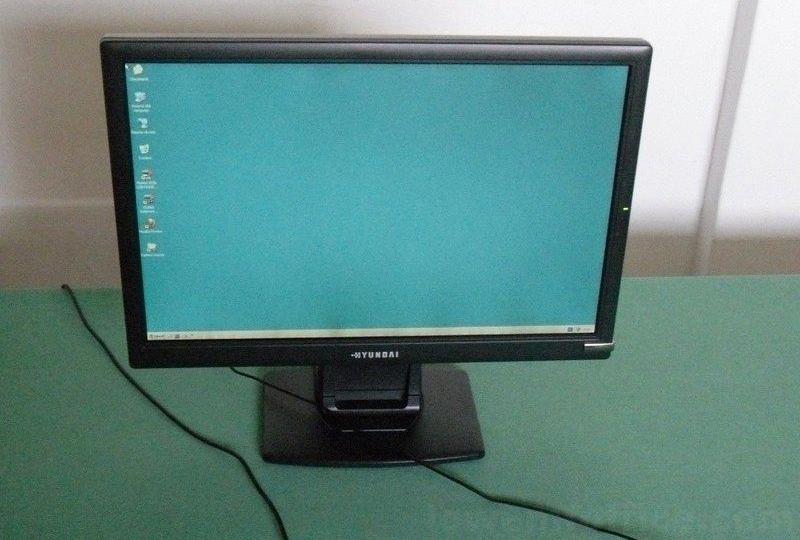 Modified Samsung 2233RZ, 22", 16:10, DVI-DL
Modified Samsung 2233RZ, 22", 16:10, DVI-DL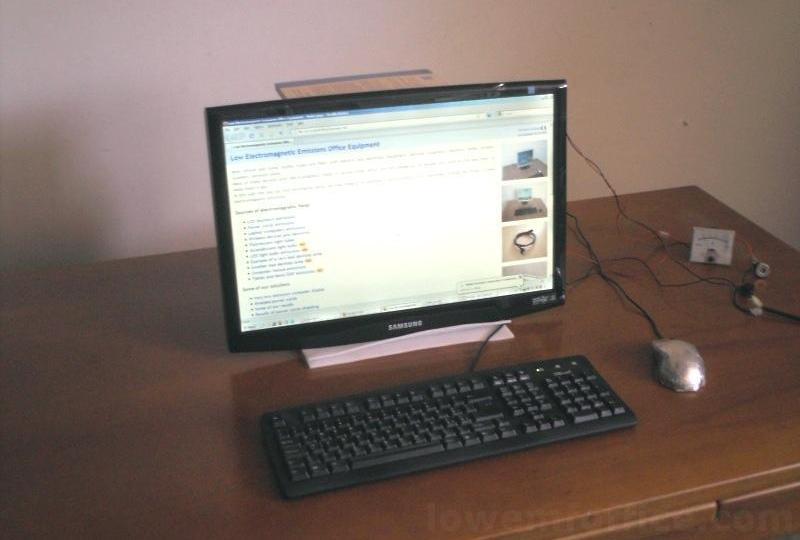 Modified Acer V19B, 19", 1280x1024, VGA + DVI
Modified Acer V19B, 19", 1280x1024, VGA + DVI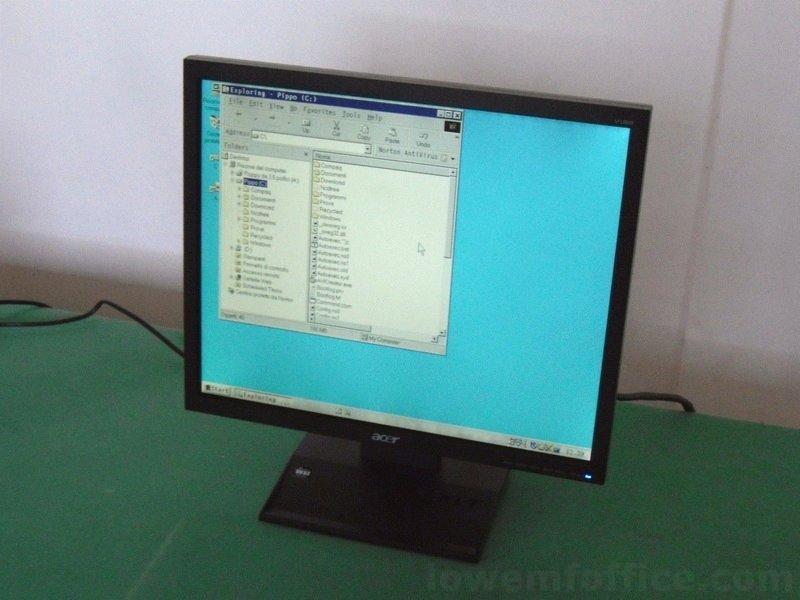 Modified LG Flatron L192WS, 19" 16:10, 1440x900, VGA
Modified LG Flatron L192WS, 19" 16:10, 1440x900, VGA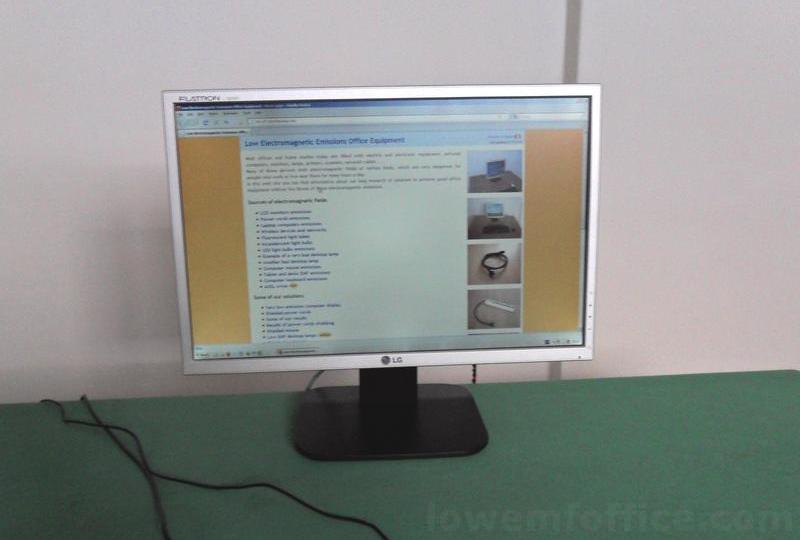 Modified Acer V193WE, 19" 16:10, 1440x900, VGA
Modified Acer V193WE, 19" 16:10, 1440x900, VGA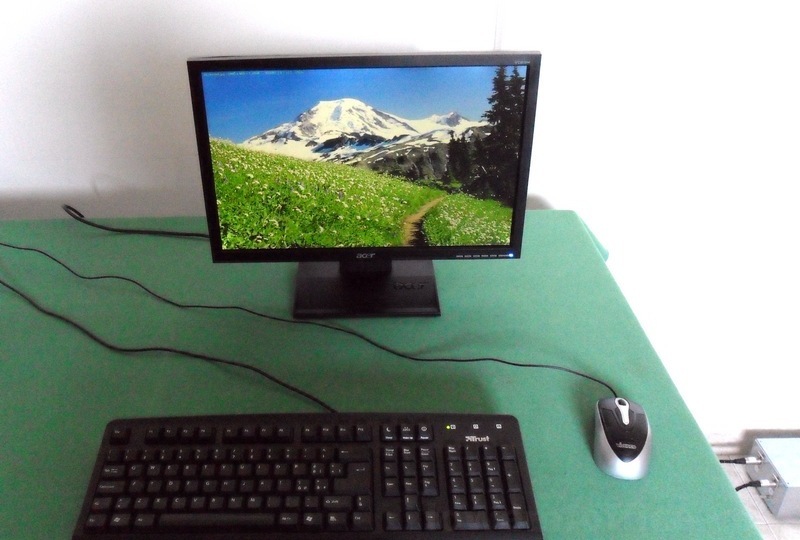
Source: http://www.lowemfoffice.com/
LOW EMF COMPUTING
http://www.wholesalependant.org/quant...Bioexcel EMR Shield - Anti Radiation Sticker is highly advance brackthrough in technology which can successfully reduce the harmful effects of EMF Radiation by up to 99%. One of the key ingredients used in Bio Ceramics from Japan which is able to emit Negative Ions, FIR and Scalar Energy. Do we realize that when we use our laptop or talk on mobile phone, how much EMF radiation we are exposed to? Radiation of mobile phone is mainly more harmfull on the head and can cause us headaches, dizziness, Insomnia and hair loss. This tin patch of Bioexcel Anti Radiation sticker can stick to your mobile phone and absorb most of the harmful radiations produced while sending/receiving signals on your mobile phone
Revised 10/1/12
SUMMARY:
1. There is presently no such thing as a zero EMF monitor or computer, but there are methods to lower their EMF (described below).
2. Turn off all electronic devices at night, and whenever they are not being used.
3. Do not use WiFi or any other wireless devices. Be certain that your computer's Wi-Fi and Bluetooth are turned completely off.
4. When using a laptop, set it to full brightness (see below), and preferably use it on batteries, and not while plugged into the charger. Leave the charger/power supply/power brick unplugged from the wall when you are not charging the batteries. Never use a laptop in your lap, and preferably use it with an external mouse and keyboard. A solid-state hard drive will have less EMF emissions - particularly important in laptops.
5. Avoid switching type power supplies and chargers; substitute the old-fashioned linear type of power supply instead. UPS units (Uninterruptible Power back-up Supplies) include a switching power supply that is on 24/7.
6. Try turning off all computer sound. This may inactivate the sound chip which can be a source of EMF because it utilizes pulse width modulation - a chopping at high frequency (similar to in a switching power supply) in its generation of sound. The most EMF may be generated while displaying streaming video - this data is coming in hundreds of times faster than when simply surfing the net.
7. Distance plus the use of optical cables can be very helpful in reducing EMF exposure.
8. The Apple iMac models are a dangerous choice because the computer itself is integrated into the monitor (they have been the cause of greatly increased sensitivities in two of my clients).
9. Most shielding is not very effective.
10. EMF exposure from more than one device simultaneously is often additive.
11. Terminate your computing session before symptoms accelerate.
12. The (PC/Windows) computer with the lowest EMF may be the fit-PC mini desktop, run on an external
12V battery or a external 12V linear power supply. The EMF and power draw will be lowest if its hard drive is solid state. The website of a US distributor, Red Post, is: http://www.thefitpc.com/. Their "fit-PC3 Low Power" may be a good choice. Talk to Jerry at Red Post; he can configure it any way you want, and can even remove the wi-fi card.
13. A truly low emf monitor probably does not presently exist. I am working on one. SEE: "SOLUTIONS" AT THE BOTTOM OF THIS ARTICLE.
14. A relatively "lower" EMF laptop may be a new HP model because it has an ultra-low voltage, low wattage (17 watt) processor, and is "all-metal": http://shopping.hp.com/en_US/home-office/-/products/Laptops/HP-ENVY/A9D34AV?HP-ENVY-Spectre-XT-Ultrabook-13t-2000&jumpid=re_r11260_evny14_spectre_xt_overview_buy_now_jun12
It has a solid-state hard drive, and an external 65 watt power adapter. It could have less than the usual EMF, or it may have very strong EMF. No one I know of has tried it yet, and neither have I. If you try it, please let me know whether or not it works for you.
There is presently no such thing as a zero EMF monitor or computer. Some are much lower than others, but all radiate EMFs. It is impossible to shield all the emissions (see my article: EMF Scams). Most computer manufacturers are in denial about EMF sensitivity. I don’t think we can expect any (except in some cases inadvertent) help from them for many years.
Everyone who is electrically sensitive has their own particular frequencies that bother them the most - each person is different. Furthermore, there are no criteria that enable one to predict with certainty, on the basis of published specifications, which computers have less emissions. Some EMF meters, or a combination of various EMF and gaussmeters, may give a rough idea, but only as a general and not completely reliable guideline. This is a very complex subject, but in general, some laptops and some netbooks have a better chance of working for people than most towers/desk-top units. Unfortunately it is trial and error: buy only with a money-back return policy. (In the case of Apple this may only be possible if you purchase directly from Apple - their AppleStore - but they do charge a restocking fee. My first all-aluminum 13" late 2008 Apple MacBook 5.1" was not bad; but the 2010 Apple MacBook Pro 15" is reported to have very high EMF.)
People might tolerate a computer at first, and then gradually become sensitized to it with longer use. If you begin to notice symptoms, it would be prudent to terminate your computing session before the symptoms begin to magnify. Take a break for a few hours, and don't turn on your computer again until well after your symptoms have dissipated. If you persist beyond a certain point, then you can be more sensitive for days.
It is best to get a computer that has a power supply that is external, and/or can be battery operated. While operating from batteries, unplug any charger; be sure to leave the charger / power supply / power adapter / power brick / wall-wart unplugged from the wall when you are not charging. Most chargers and most power supplies, either inside computers or stand-alone supplies, are of the "switching power supply" type, which usually generate huge amounts of EMF that is both conducted along wiring and cabling, and also radiate into space. The older, less efficient "linear power supply" type has much less high frequency EMF than the "switching" type. Switching" refers to chopping the power at a very high frequency in order to be able to use a very small transformer to do the voltage conversion. Linear supplies do not chop the power at high frequency and therefore require a larger, heavier and more expensive transformer. This transformer does have a large but only local 60 Hz magnetic field which does not radiate for more than a few feet, whereas the high frequency RF of switching supplies radiates for great distances, both through space and throughout the house on the house wiring. It is very difficult and expensive to effectively filter and shield a switching power supply. The linear supply puts some noise on the powerline, but the amount of this noise is far smaller than what the switching types inject. Any power supply is best plugged into the wall via a good AC line filter. Linear power supplies are still available, and I have successfully replaced many switching-type supplies with linear supplies to significantly lower the EMF of a system, and this requires some custom work. A switching-type supply can alternatively be replaced by a rechargable storage battery followed by a linear voltage regulator.
Use a laptop or monitor screen only at full brightness, since brightness reduction usually brings a dimmer-switching circuit into play which generates much more EMF. When a laptop backlight is set to a lower than full brightness setting, the RF emissions usually increase noticably. For this reason, set the backlight intensity to 100%, and if this is too bright for your eyes, either use sunglasses or put a filter in front of the screen, or just increase room brightness to compensate. This dimmer-switch effect may not be true for all screens, but can be checked out with an AM radio as a RF sensor.
Using an external keyboard and mouse is usually better than keeping your hands directly on the laptop. The old-style mechanical roller-ball mouse or trackball usually has less emissions than the modern optical mice. Keyboards vary widely in their emissions (they all contain their own microprocessors). The Macally IceKey may be better than most. Do not use WiFi or any other wireless devices.
For further EMI reduction, optical fiber cables are available: optical USB to connect keyboard, mouse and even printer to the computer, optical DVI or HDMI for connecting an external monitor or projector and also optical media converters for connecting modems, routers and networks to computers through optical ethernet. These optical links usually consist of a small "upstream" box connected to the computer and powered by the computer through this connection, a small "downstream" box connected to the peripheral device, and optical fiber connecting the two boxes. The fiber connection can be of almost any length, sometimes up to many hundreds of feet. The downstream box requires a power source, often a small 5 Volt supply. Be sure that the setup does not include or require a copper/metal conductor either bundled with the optical fiber or as a separate cable for supplying this downstream power. Manufacturers often sneak in this electrical conductor without clearly telling you, and this results in a connection that can conduct EMF from the computer since it is no longer purely optical fiber. When a stand-alone power supply is included for downstream power, it invariably is an EMF noisy switching supply, and so it should be replaced by either a linear power supply running off of AC power, or by a rechargable storage battery and a linear voltage regulator. I can supply more information on optical cables and power supplies to power them, via telephone consultation.
A solid-state hard drive will have less EMF emissions and will provide a longer battery life than the standard mechanical hard disk drive, and many of the newest laptops and netbooks offer a solid-state drive as an option. This option usually costs more, but the prices are coming down rapidly.
Some persons have tried to use a projector or pocket projector as their monitor so that they can sit farther away than from the usual monitor screen, but unfortunately, all of the projectors I have tried or know about have far stronger (even at a distance) EMFs than an LCD monitor. This is due to the switching power supply necessary to power the lamp, or the pulsing of the LEDs in a projector with a LED source.
LCD screens with LED backlight are usually no better than the old fluorescent backlight as far as EMFs go, because the LEDs are usually pulsed, and their supply is of the switching type.
For a chemically sensitive person, any of the Apple iMac models would be a dangerous choice for the following reason: about one-half of chemically sensitive persons eventually develop electrical sensitivities, especially from sitting near computers for a long time, and the iMac places not only the monitor, but also the computer processor, drive and switching power supply irrevocably only two feet from your face. On the other hand, when the computer is separate from the monitor, you have the option of moving the computer with its power supply further away from you. In general, most EMI emissions decrease with distance much faster than you might expect; the intensity is often inversely proportional to the square of the distance. This means that the intensity at 4 feet can be 1/4 of that at 2 feet, and at 8 feet it can be reduced to 1/16th. Although this is significantly helpful, it is not quite as helpful as it seems, because living cells are logarithmic in their sensitivity (see my discussion of this in part 4.D in my article "EMF Scams"). The longer cables required when a computer is moved further away can increase the overall EMF's, and possibly EMF's perceived, because the longer cables act as better radiating antennas. This is best remedied by using optical cables, but even these can have emissions at their downstream end, where the optical signal gets re-converted to electrical, that may affect some people. But greater distance and the use of optical cables usually end up being the best solution.
Amateur attempts at shielding are usually not very effective. Proper shielding requires a great deal of engineering expertise and experience, and is expensive. Aluminum foil will shield some of the high frequency EMF, but only if it is close to and covers the radiating source completely and also extends beyond the sides of the source.
In general, laptops have lower emissions than desktops, not only because they can be run on their internal batteries, thereby avoiding a main switching power supply, but also because they are highly integrated, compact and more efficient in their use of power. Laptops also avoid the need for an auxiliary back-up power device such as a UPS which are intense generators of EMF because they have a switching power supply that is always running. If you get a laptop, it is probably best to get one with a unibody metal case, which may provide some shielding. A solution (but probably an imperfect one) for an electrically sensitive person could be a relatively low emission netbook or laptop running only on its internal battery, placed at some distance and used together with a wired keyboard and mouse, and with an external monitor if you can find a monitor you are not too sensitive to. The best bet for a monitor would be a model with an external rather than internal power supply, especially if that external switching supply were to be replaced by a linear type of supply.
The additive principle: EMF exposure from more than one device simultaneously is often additive. If you do not feel any EMF effect from a first device when it is on alone, it can nevertheless be increasing your sensitivity to a second device when both devices are on at the same time.
I have had success (much reduced EMF) with a projector I designed and built myself, and with TV's in which I have replaced EMF-noisy switching power supplies with quiet linear-type power supplies, and with portable, battery powered DVD players. I have been modifying LCD's for use as TV's or monitors for others on a custom basis.
SOLUTIONS:
Since it is nearly impossible to shield a flat screen monitor to a high degree (and still be able to see the screen easily), I feel that using a shielded projector as a monitor via rear screen projection from a distance is the way to go. I am presently designing a special shield box for a projector. A very low emissions computer that can be used with it, either inside the shield box, or outside of it, is the FitPC-3: http://www.thefitpc.com/ . My shield box will provide a very high degree of shielding of the projector, and I expect that it will be comfortably usable by most persons who are sensitive to their monitors and computers. My tentative timetable: XGA or WXGA projector in shield box (with or without computer) December 2012; very low EMF mouse, December 2013, near-zero EMF keyboard May 2013. Unfortunately it is all quite expensive, but for many of us it is the only way that we can continue to work.
Some people may be able to tolerate a less expensive intermediate solution: a LCD monitor that has a separate power adapter that can be replaced with a linear power supply. In some cases it may be possible to also change the pulsing power that normally supplies an LED backlight to DC, but this requires custom work. Many monitors will still have too much EMF even after changing the power adapter, but a few may be tolerable. It is a crap shoot - no way to predict in advance, although an RF sensor/meter may give some relative indication. I am currently building a hooded partially shielded box with a shielding viewing window for a LCD monitor.
To summarize this intermediate option:
1) LCD monitor selected for lower EMF, having separate power adapter replaced with a linear supply;
2) optionally customizing the power to the backlight, if backlight is LED;
3) optionally putting the monitor inside a shield box with special shielded viewing window;
4) use with a low EMF computer at a distance, such as a fitPC-3 Low Power with an internal solid-state hard drive-SSD and with its wi-fi card removed (talk to Jerry at RedPost: http://www.thefitpc.com/products/fit-pc3-lp , he can configure the computer any way you want) and powered by a linear 12VDC supply);
5) using an optical cable to carry the video signal from the computer to the monitor; I recommend the Rainbow Fish Optical HDMI Professional Cable ( http://www.rainbowfishcorp.com/ ) for which I am a dealer - I can give you the best price;
6) and using a second optical cable such as a fiber-only Opticis Optical USB Cable ( http://industrialcomponent.com/opticis/optusbext.html ) to carry the USB signal from the computer to the keyboard and to an old-fashioned roller ball mouse.
Source: http://www.conradbiologic.com/articles/%20LowEMFComputing.html
Source: http://www.ahappyhabitat.com/computer.html
My 9 Tips To Cut Down On Exposure To Computer Radiation
Who can get by without using a computer today? I’m electrosensitive, but I know I definitely couldn’t. While cell phones are a definite no no for me, and always will be unless the current technology changes radically, computers are different.Computers emit electromagnetic fields (EMFs) on many different frequencies. There is no longer any doubt that these EMFs are extremely harmful to your health. In this article I explain what you can do to minimize your exposure to these harmful EMFs. I have also written a separate report on a low emf office set up – see bottom of page.
Whether you are electrosensitive or just eager to take protective measures to protect you and your family here are my (started off as 9 tips but has now grown) tips on how to best reduce radiation from your laptop or desktop PC.
http://electricsense.com/
Are You At Risk From Electrosensitivity?
Many people, including me, are developing electrohypersensitivity due to the increasing levels of public exposure to wireless devices like cellphones, computers, wireless routers and printers to name only a few.
"We are electromagnetic beings," said Camilla Rees, one of the foremost opposants of the use of dangerous cellphone and wireless technologies. "We are especially vulnerable to unnatural electromagetic fields."
The Dangers of Electromagnetic Radiation
Developing Electrosensitivity can cause symptoms like excessive fatigue, difficulty in concentrating, irritability, sleep disturbances, headaches, visual problems, memory loss, dizziness, and cardiovascular disruptions. The symptoms from Long-term exposure can lead to Fibromyalgia and other chronic pain syndromes like cancer.
How Dangerous Is Electromagnetic Radiation To You?
Magda Havas, Ph.D., has claimed that all it takes is just small doses of electromagnetic radiation over a long period of time to become sensitive towards it. She said, "Symptoms of electrohypersensitivity have been demonstrated at exposures that are a fraction of U.S. exposure guidelines, in part because the guidelines themselves only take into consideration a 30-minute exposure, not chronic exposures."
Dealing With Electrosmog
The term Electrosmog was created in the sense that electromagnetic radiation pollutes the air around us in the same way that smog does. Electrosmog is the combination of the different intensities of electromagnetic fields from cell phones, wireless computers and networks, and many other electronic devices. The long-term effect that electrosmog has on our health and DNA is still unclear but it is certain that it envelops us every day. It is in your homes, neighbourhoods, and workplaces. Avoiding it is almost impossible.
How can You Protect Yourself?
Learning more about the dangers of electromagnetic radiation and how to protect yourself is the best thing you can do. Download my free report now. I know what is happening because I am Electrosensitive.
Laptop Radiation And Computer Radiation Tips
1. Because more and more people are turning towards using laptops, laptop radiation is increasingly becoming a problem. There are several issues here, the first one is magnetic radiation:As my tests show (see video) the best way to cut down on your exposure to magnetic radiation from your laptop is to use it on the battery instead of the mains power supply.
2. The second issue is radio frequency radiation, or RF radiation. More and more computers, particularly laptops are equipped with WiFi. This means you are being exposed to another layer of electrosmog from two sources. Firstly from the laptop itself; most laptops are configured by default to be in WiFi mode, so even if you are on a hard wired Internet connection your laptop is still emitting and receiving RF radiation. Secondly there is the RF radiation from the modem/router as shown in this video:
The best solution is to replace your WiFi installation with a hard-wired connection and make sure the WiFi function is disabled. My personal preference is the Netgear DG834 router because you can easily switch the WiFi function off and it stays off, I have tested this. Be careful because many modem/routers are now factory configured to automatically re-enable WiFi when they receive an update, which can be several times a day.
3. The best way to minimize laptop radiation is not to use your laptop PC on your lap. Studies show that over time using your laptop on your lap can significantly decrease your sperm count. An effective solution to this problem is to use a Harapad to protect your self from laptop radiation. By sitting your laptop computer on a Harapad you can effectively shield your body from the magnetic radiation it produces.
4. The monitor is usually the biggest problem, not the CPU, so sit a bit further from the computer screen. This will mean that you are exposed to less radiation, especially if you sit at least two feet from the screen – electromagnetic radiation exposure decreases significantly with distance. If you are using a desktop you can use a radiation filter over the screen or better still purchase a degaussed screen.
5. Those of you who enjoy houseplants will be happy to learn that some cactus plants have the ability to absorb the electromagnetic radiation coming from the computer. It was actually NASA who discovered this and ever since Cactii have become my best friend; my office is full of cacti. Put some cacti around your computer, I use Cereus cacti.
6. Use a natural crystal salt lamp. I have had one in my office for several years.

salt lamp
7. Almost everyone who uses a computer for several hours a day is all too familiar with eye irritation. Computer screens not only cause eye strain, but the electromagnetic radiation also causes dryness and irritation. You can help to counter damage and irritation to your eyes by adding bananas to your diet. Bananas contain significant amounts of potassium, which will benefit the health of the eyes.
8. So much has been said about the value of antioxidant food in keeping us healthy generally, but these foods can also help to deal with free radicals caused by computer radiation. Tomatoes, cherries, apples, broccoli, and carrots all contain significant amounts of vitamins A and C, and these foods are important in keeping our bodies safe from the dangers of computer radiation. Again, in my view, organic food is to be preferred in combatting cell phone radiation.
9. It might come as a surprise to you to learn that simply washing your face after using the computer can remove the radiation that has settled there. Our faces are usually the closest part of our bodies to the screen, and the particles of radiation will attach themselves there. Some people have found that the use of a facial mask before turning on the computer can also help to cut their exposure to electromagnetic radiation.
10. Go wired; wired mouse, wired keyboard and wired peripherals. Even if you are using a laptop using a wired external keyboard will significantly reduce your exposure to the EMFs emitted by the electrical components situated under the keybaord of the laptop.
If you work in an office where there are several computers, make sure you are not in close proximity (a meter or two), to the back of someone else’s PC screen. Remember its not just your computer its other people’s aswell that you need to be wary of.
Laptop Radiation The Biggest Threat?
In absolute terms I have not found that laptops emit higher levels of radiation than desktops, this does vary a lot and the only way to know for sure your exposure levels is to measure them with an EMF meter. The problem with laptops is improper use. A lot of people are using them on their laps and on their knees which is very dangerous. Maintaining a safe distance between you and your laptop is the most effective way of minimizing your exposure to laptop radiation.Radiation levels vary from computer to computer (interestingly I have found the Macbook Pro to emit RF radiation from the mouse even with WiFi disabled).
Grounding and Computer Radiation
A good way of reducing the effects of your exposure to computer radiation is grounding. You can ground your laptop or desktop computer by attaching a wire from a metal component (screw or socket) of your computer to the ground terminal on your electricity wall socket. Electricity follows the path of least resistance, so this will enable EMFs generated by your computer to ground through the wire and not through you. You can also earth yourself using a grounding mat but I don’t recommend doing this when using your computer (or in any environment where there is electrical equipment), see my article on earthing.Source: http://www.electricsense.com/1138/my-9-tips-to-cut-down-on-exposure-to-computer-radiation
Safer Computing: Creating a Low EMF Computer Environment
Extensive computer use can be a contributing factor to electrosensitivity, or electrical sensitivity. A computer may have a combination of all different kinds of electromagnetic fields from wireless radiation (Wi-Fi), to radio-frequencies from the electronics, to electric and magnetic fields. The following are some solutions to mitigate these EMF's, divided by source of EMF (laptop, internet, peripheral, monitor) and then by category of EMF (wireless, radio frequencies, magnetic, electric).Laptop EMF Safety
1. Wireless Safety: How to Disable Wireless Internet on a Laptop (Windows)
A wireless adapter may be transmitting even when it is not connected to a wireless network-- some adapters transmit more frequently than others. The following instructions show how to disable the wireless adapter so that it stops transmitting.Disable Wireless: (Control Panel > Network and Sharing Center > Manage network connections or Change adapter settings). Right-click the Wireless Network Connection and select "Disable".
Create a software shortcut: Right-click and select the option to create a shortcut on the desktop so that the connection can be enabled or disabled more easily.
Use hardware shortcuts to disable wireless: For some laptops, there's an external on/off switch on the side of the laptop or shortcut combination such as Fn-F2 to turn Wi-fi on or off. Check for the wireless icon on the F1,F2,F3... keys to see if there is a shortcut.
Note that the wireless router is always transmitting regardless of whether or not a computer is on the network. Learn more about switching to a wired routers.
2. Powerline Magnetic Safety of Laptops
Laptops tend to have higher powerline magnetic fields than desktops, but these fields can be kept to reasonable levels with a little distance (e.g., 1 meter). In any case, one of 11 precautions listed in Prevention magazine states "8. Keep your laptop off your lap."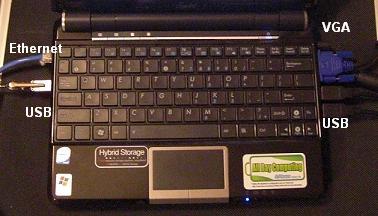
If you run out of USB interfaces, you can use a 4-port USB hub to expand the number of ports. Some keyboards have more magnetic or electric fields then others, so choose one with a gaussmeter and volt sensor handy. Avoid unnecessary bells and whistles such as illuminated keyboards.
3. Intermediate Frequencies (kHz Radio Frequency) Safety
The laptop's power cable/AC-DC adapter has a transformer that can introduce digital harmonics that get carried to the computer and then to the USB cables plugged in to the laptop. Thus, it is preferrable to buy a long-battery life laptop, and run it off of battery, unplugging the power supply when possible. (Wrapping the transformer in aluminum foil might be another option.) However, this is not always enough, as the laptop itself can introduce digital harmonics as well. A netbook with a simple processor and a long battery life may be a good choice for someone sensitive to EMF.
Monitors, ethernet switches, and ethernet cables can also be a significant source of intermediate frequencies, discussed further below.
4. Electrical Safety & Grounding for Laptops
2 pins
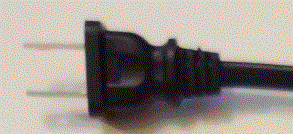 rather than 3 pins
rather than 3 pins  are not grounded. As a result, when they are plugged in, they can increase one's body voltage, the voltage as measured between one's body and the ground. The Building Biology Indoor Environment Checklist recommends 3-pin over 2-pin plugs and body voltages less than 100 millivolts. Some laptops do use 3-pin plugs, but not all.
are not grounded. As a result, when they are plugged in, they can increase one's body voltage, the voltage as measured between one's body and the ground. The Building Biology Indoor Environment Checklist recommends 3-pin over 2-pin plugs and body voltages less than 100 millivolts. Some laptops do use 3-pin plugs, but not all. If you have a laptop with a 2-pin plug, there are still easy solutions to reduce your body voltage.
- If the laptop is plugged into a grounded monitor with 3-pin plug, it may be grounded automatically.
- Otherwise, one can obtain a grounding cord for the laptop and connect it to a metal interface on the laptop, such as the USB port. See instructions for laptop grounding.
- The other solution is to unplug the laptop power cable and run it off of battery.
Important: Do NOT attempt to ground yourself in a high electrical environment. For more info, see Electric Fields. Note that grounding requires a properly grounded outlet or the earth outside.
Desktop EMF Safety
Prefer shielded to unshielded power cables: If you have a desktop, the AC power cord can be replaced with a shielded one. (Note that this will work for desktops, not laptops.) Shielded cables can be found at Radio Shack or amazon.com and the cable itself is labelled with the word "SHIELDED". Ideally, the cable will be rated as RoHS (Reduction of Hazardous Substances), and not offgas signficantly from the PVC jacket. Note: The shielded cable can be used for desktops and monitors. Note: The shielded cable, while shielding electrical fields, may also amplify certain frequencies locally, so a distance of at least 2-3 feet is still recommended, even from shielded electrical cables.Internet EMF Safety
Safer Internet -- Switching from Wireless Internet to Wired Internet
Wireless Internet
 Your internet access via cable modem, DSL, or FiOS, may have come with a wireless router by default. These wireless routers transmit all the time by design, even when the internet is not in use. See just how strong wi-fi signals are and recommended distances Some models of wireless routers allow users to disable the wireless capability using the web-based setup interface. A few models even allow for power level reduction (e.g., up to a factor of 10) and/or scheduling capability.
Your internet access via cable modem, DSL, or FiOS, may have come with a wireless router by default. These wireless routers transmit all the time by design, even when the internet is not in use. See just how strong wi-fi signals are and recommended distances Some models of wireless routers allow users to disable the wireless capability using the web-based setup interface. A few models even allow for power level reduction (e.g., up to a factor of 10) and/or scheduling capability. Wired Internet via Wired Router and Ethernet Cables
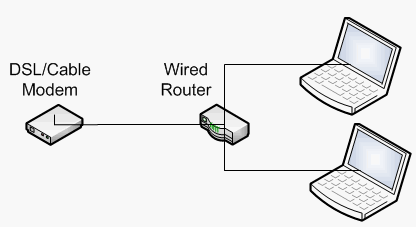
The alternative is to hard-wire your internet connectivity with a wired router and some Ethernet cables. The illustration uses a wired router to connect multiple computers to the internet via Ethernet (RJ45) cables. Note that a router must be used rather than a switch to accommodate multiple computers.
Some routers may inject radio signals onto the ethernet cable, as detected by a sensitive AM radio set to the right frequency and pressed against the cable. Oftentimes a device with fewer ports will have less radio signals. Check also for body voltage, and if necessary, ground the router or switch by connecting a grounding cord to the metal surface near the ethernet ports.
Wired Internet Extended with a Switch
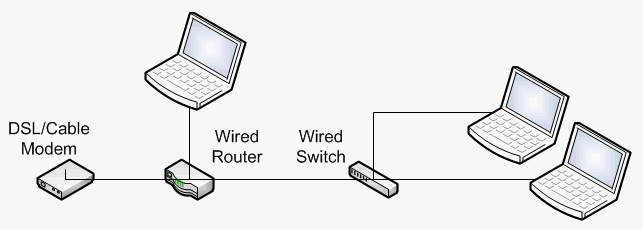 Note that you need a router rather than a switch to connect to your internet cable or DSL modem, if multiple computers are going to connect to the internet. However, a switch, can still be combined with a router to extend connectivity to other rooms.
Note that you need a router rather than a switch to connect to your internet cable or DSL modem, if multiple computers are going to connect to the internet. However, a switch, can still be combined with a router to extend connectivity to other rooms.
Again, check your switch for intermediate frequencies it may inject onto ethernet cables. You may find a switch with fewer ports will have less radio-frequencies. Check also for body voltage, and if necessary, ground the router or switch by connecting a grounding cord to the metal surface near the ethernet ports.

In the photo at left, the smaller switch (left) appeared to be normal, but the larger switch (right) would inject strong radio-frequencies onto the ethernet cable when more than one or two active ethernet cables were plugged in. Both intermediate kHz radio frequencies and voltages may be carried along the entire length of the Ethernet cables. Thus, it is important to choose a router/switch with less radio frequencies to begin with, and to ground it if it has a 2-pin prong and is adding significantly to body voltages. Note that wired routers and switches may also have some AC magnetic fields so a distance of 1 meter is also recommended. Remediation can be tested with a meter.
Cordless Phones Health Rsks : http://www.emfnews.org/Car-Radiation-...
Blue tube headset : http://www.emfnews.org/mret-technolog...
The Independent (9.09.2007):
The Environment ministry of the German government in September 2007 said that people should avoid using Wi-Fi wherever possible because of the risks it may pose to health. The official radiation protection body also advised its citizens to use landlines instead of mobile phones, and warns of "electro smog" from a wide range of other everyday products.
• Base stations affect health negatively. Among people living closer than 300 m away from the base station, a French study found
an increased incidence of tiredness within 300m, of headache, sleep disturbance, discomfort, etc. within 200 m, and of irritability, depression, loss of memory, dizziness, libido decrease, etc. within 100 m.
Women were found to complain significantly more often than men of headache, nausea, loss of appetite, sleep disturbance, depression, discomfort and visual perturbations. This study, based on the symptoms experienced by people living in vicinity of base stations recommend that the minimal distance of people from cellular phone base stations should not be 300 m. (Santini R, et al 2002)
New Zealand
Austria, Vienna
Serbia, Belgrade
Lebanon, Beirut
Czech Rep, Prague
Bulgaria, Sofia
Kiribati, South Tarawa
Andorra, Andorra la Vella
Sydney, Australia
Luxembourg, Luxembourg City
Cell Phone Radiation Dangers : http://www.emfnews.org/testimonials.html
Home Radiation Protection : http://www.emfnews.org/home_protectio...
EMF Safety with Computer Peripherals Like Mouse and Keyboard
Peripherals
Mouse: A wireless mouse may come with a USB receiver that is constantly transmitting radiation. For reducing wireless emissions, choose a USB wired keyboard and USB wired mouse over a wireless keyboard and mouse. Even wired mouse and keyboards have differing amounts of magnetic fields, electric fields, and radio frequencies (intermediate frequencies), so further care can be made to select the lowest one. Covering the top of the mouse with aluminum foil might be helpful to reduce some of the radio-frequencies. Another possibility is to obtain a USB keyboard with a built-in touchpad rather than getting a mouse, which will also free up one USB port.Keyboard: Some mini keyboards may have high magnetic fields but not electric fields. Other mini keyboards may have high electric fields, but not magnetic fields. Note that these devices can sometimes cross-contaminate each other, e.g., a USB keyboard's intermediate frequencies can be passed to a USB mouse.
To reduce keyboard use, consider also the following alternatives:
- Use a wired microphone plugged into the microphone jack with voice recognition software.
- Use Windows 7 accessibility features which can display an on-screen keyboard, thus eliminating the need for a keyboard. Through the Windows 7 On-Screen Keyboard's Options button, auto-mouse clicking can also be activated to reduce any risk of repetitive strain injury. Alternatively, software such as E-Quill-Liberator can also be used to reduce the need for mouse clicking. These auto-clicking options click the mouse during significant pauses over buttons.
Headsets have some AC magnetic fields, and having them directly at the ear is not good for chronic periods of time. If possible, minimize use of headsets, or get an air tube headset. When using headsets, keep the sound volume as low as can be done comfortably. Typically, the higher the volume, the higher the power line EMF.
Speaker - If a speaker is used, it should be kept at a distance.
Microphones - Some USB microphones, like Polycom, have some magnetic fields; using the microphone jack itself may be a safer alternative.
Lighting : The power cord for a lamp has electric fields. If the lamp is metal continuously from the socket to a metal screw at the base, then it can be grounded with the help of a certified electrician. The wire will be cut at the base, and connected to a shielded, grounded cable with wire nuts, hot to hot and neutral to neutral. The green grounding wire and fourth bare wire can be twisted together and then connected via the screw at the base, with the help of a wrench to loosen it so that the grounding wire can be inserted, before tightening it. This requires wire nuts, and determination of which wire is hot versus neutral. See video on how to ground a lamp.
Computer Monitor EMF Safety
Choosing a Low EMF Computer Monitor
Powerline Magnetic Safety: To reduce power line magnetic fields, prefer LCD flat panel monitors over CRT monitors. Some of the old-fashioned box-shaped CRT monitors, are high in powerline magnetic field (in all directions), and may also cause exposure to higher ionizing radiation toward the back. Most LCD Flat Panel monitors, in contrast, have low powerline magnetic fields. You can check for TCO compliance for low AC magnetic fields, or use a gaussmeter to evaluate the LCD flat panel for power line magnetic fields. The following TCO search can be used to identify the display of your choice.Intermediate Frequencies Safety: Due to CCFL back-lighting, LCD flat panel monitors, even TCO-compliant ones, will still have intermediate frequencies (kHz radio frequencies), as detectable with a sensitive AM radio set to the lowest frequency. For long-term users, it is recommended to keep a distance of at least 4 feet from the monitor and avoid excessive use, if possible. Changing the screen resolution to a lower resolution, e.g., 1024x768 instead of 1280x1024 is one way to quickly increase the font size for comfortable viewing at a distance. For web browsing, Ctrl-'-' and Ctrl-'+' can be used to decrease or increase font as necessary. Another solution which has been recommended is the Fresnel magnifying glass.
Some have suggested that LED monitors will have lower levels of intermediate frequencies, but the electronics that are supporting the LED's may significantly reduce any advantage this provides. For example, edge-lit LED's might result in lower intermediate frequencies than full-array LED's. Some individuals may also be sensitive to the blue light.
Electrical Safety: To reduce electric field exposure, you should observe some distance from the power cords. Shielded power cables are available, but they could potentially increase some intermediate frequencies locally, and should still be used with distance. Look for the word "Shielded" imprinted on the cable itself.
Other Considerations: Do your resesarch online before your purchase of an LCD flat panel monitor, even if it satisfies TCO and low intermediate frequencies, to make sure it satisfies your desired resolution level, and other factors. To prevent flicker which causes eye fatigue, make sure you can set your screen refresh rate to 75 Hz instead of 60 Hz. Many laptops can only achieve 60 Hz, but many LCD monitors can support 75 Hz. (Instructions for Windows Vista: Control Panel > Personalization > Display settings > Advanced Settings > Monitor tab > Screen refresh rate > 75 Herz).
Since the Intermediate Frequencies can still be bothersome, distance and time limits are advised for computer usage. Readily achievable distances are 4 feet from the monitor (with 800x600 resolution for readability at a distance), 2 feet from the keyboard and mouse, and 6 feet from a netbook computer, and 4 feet from power cords. When possible, print out documents to read away from the computer, with power and USB cables unplugged. When shutting down the computer, turn it off from the power surge strip if possible, since the cable draws energy even when the device is not powered on. Unplug USB cables which may still draw power from the battery.
cell phone anti radiation chips test with EMF Radiation tester
www.Anti-Radi.com All Rights Reserved
Anti Radiation and Battery salvage sticker
Anti Radiation and Battery salvage sticker Features:
1. Absorb and transfer electromagnetic radiation waves by using special materials and reduce mobile phone radiation injury on the human brain of 99.99 percent.
2. Extend the service life of rechargeable battery two to three times.
3. Quick charge and save 50% of charging time.
4. Resume the battery capacity and extend the standby time 0.5-2 times.
OEM ODM custom printing service for anti radiaton sticker avilable
Chemical Safety - Flame Retardants
Handling New Electronics
New electronics should ideally be aired outside when you first power it on, in case of release of chemicals like brominated flame retardants (See Gunni Nordstrom, The Invisible Disease).See the Precautionary Measures page for more information.
Reference
How To Protect Yourself From EMF
About EMI and EMF
EMI or Electromagnetic Interference
EMI refers to factors that affect how a gadget functions. Here is an example. A unit with high EMI can cause the images on your television to go all jerky. It might also affect your radio and personal computer. All in all, because high EMI can influence the performance of electronic tools, it is rudimentary for units to be thoroughly tested first before these are mass produced. This enables EMI regulating bodies to monitor if the products manufactured and then sold in the world market are up to par.
EMF or Electromagnetic Field
Everything that runs on electricity creates an electromagnetic field that produces very low levels of radiation. Even if a device is turned off, it can still generate small amounts of radiation. Sources include but are not limited to the following: television, computer, fluorescent lamp, microwave oven, clothes washer, and hair dryer. The EPA (Environmental Protection Agency) provides information about the danger zones. There are specifications about how far you should be from units in order to remain relatively safe.
Mission: Family Protection
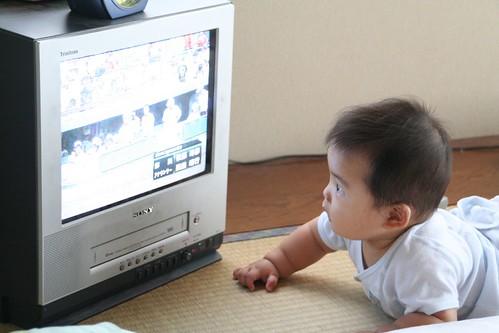
Of course, you have to do your part in protecting yourself and your loved ones from EMFs. Although there is no definitive evidence yet about whether or not EMF can drastically harm health, some claim that overexposure can result in headaches, sleeplessness, and even cancer. So, how do you lower the risk?
1. Buy new electronic appliances.
The older your television is, the less efficient it is. This goes the same for all your kitchen equipment and other devices. New gadgets are more efficient and they should have passed quality standards, which are definitely more stringent these days.
2. Check the EPA website to determine the “danger zones.”
You are in the danger zone if you’re just 4 to 20 inches away from your computer. Lower your risk by staying at least two to five feet from it. This is what the EPA recommends. There are more itemized details regarding danger zones on their website.
3. Be quick.
If you are regularly using, say, your hair dryer, then you should use it quickly to reduce the amount of time that you’re exposing yourself to radiation. This goes the same for all the gadgets found in your home.
4. Don’t sleep with your cell phones.
Most of us like to keep our smartphones and tablets nearby. But if you want to protect yourself from radiation, keep all devices at least six feet from your bed.


 There are other products that act as barriers between you and the EM field, for example metal plating or metallic fabric bags to carry your cell phone in. They basically act as a
There are other products that act as barriers between you and the EM field, for example metal plating or metallic fabric bags to carry your cell phone in. They basically act as a 




Each component of that being's body also resonates at a particular frequency. EMF Protection
ReplyDelete